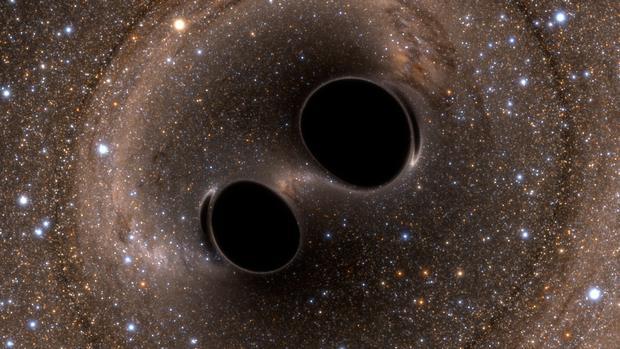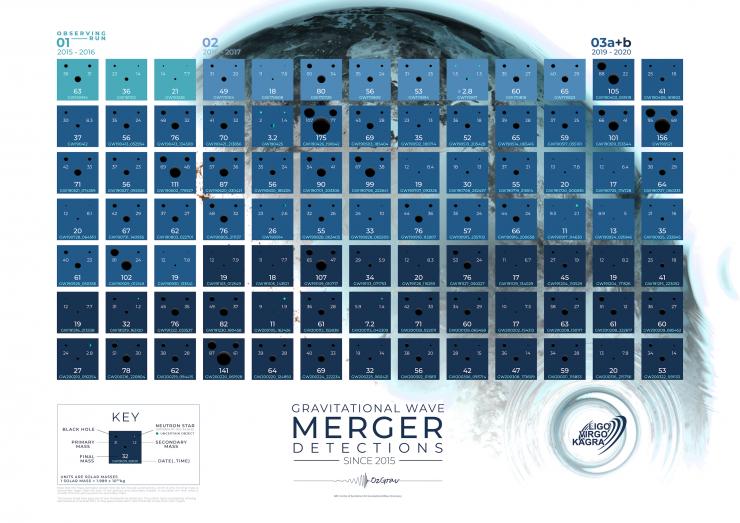Surfing Gravitational Waves: Georgia Tech Students Help LIGO Catalog All Known Space-time Ripples
Nov 09, 2021 — Atlanta, GA

An international collaboration of scientists, including a team of Georgia Tech graduate students, undergraduate students, and faculty, has released the largest catalog ever of gravitational waves from cosmic collisions of black holes and neutron stars.
This week, LIGO-Virgo-KAGRA Collaboration published a set of scientific papers on their findings, which include the detection of 35 new gravitational wave events since the last release, in October 2020. That brings the total number of these observed events to 90 since the first one was detected in 2015.
The gravitational wave findings include confirmation of intermediate-sized black holes, rare black hole-neutron star merges, and more information on extremely distant black holes.
Gravitational waves are ripples in space and time caused by black holes smashing into each other, or neutron stars colliding. Black holes are regions of extremely warped space-time caused by a very compact mass. Intense gravity prevents anything, including light, from escaping. Neutron stars are what’s left of massive stars when all their fuel has been exhausted; they become objects so large and dense (though not as dense as black holes) that atoms cannot sustain their structure as they do on Earth.
“Only now are we starting to appreciate the wonderful diversity of black holes and neutron stars,” says Christopher Berry, lecturer at the University of Glasgow, in a LIGO press release. “Our latest results prove that they come in many sizes and combinations. We have solved some long-standing mysteries but uncovered some new puzzles too. Using these observations, we are closer to unlocking the mysteries of how stars, the building blocks of our universe, evolve.”
Joshua Brandt, a second-year student in the School of Physics, is a co-author of one of the scientific papers.
“The third gravitational wave catalog not only represents a large addition to the information we know about black-hole binaries, but it also is a culmination of work from hundreds of scientists all over the world,” Brandt says. “It shows how successful large scientific collaborations can be with a diverse group of people all applying their expertise to vast amounts of data, which goes into this paper highlighting the major findings.”
The Georgia Tech connection to gravitational wave detection
Brandt is one of eight undergraduate and graduate students in the School of Physics who assisted in the research and co-wrote the associated papers. The group includes graduate students Sudarshan Ghonge, Hannah Griggs, Megan Arogeti, Erin Thompson, and Peter Lott. Undergraduates Brandt, Nadia Qutob (fourth-year), and Jack Sullivan (fourth-year) are co-authors of the paper summarizing the gravitational wave findings.
“It is amazing to get involved in this type of research so early on” as an undergraduate, says Brandt. “It's been inspiring to see how even though the members of LIGO are so busy working on groundbreaking research themselves, they take time to help any other member, including students, and get them involved. A lot of this cutting-edge research isn't just individuals with specialized knowledge all combining their results together; it thrives on willingness of experienced scientists to share their knowledge and teach those who want to become involved and contribute.”
In addition, Griggs and Thompson contributed to a second study detailing new findings on gamma-ray bursts. “We hoped to determine what kind of cosmic event caused the gamma rays we see on Earth, with special attention paid to neutron star mergers — with a black hole or another neutron star — supernovae, and unstable accretion disk formation around spinning black holes,” Griggs says. “We saw no evidence of gravitational wave events matching up with our GRB (gamma ray burst) catalog. It tells us that in the detection volume of Advanced LIGO/Virgo, GRBs that are energetic enough to produce detectable gravitational waves are quite rare events.”
Gravitational waves can also be used to test the validity of Einstein’s theory of general relativity to a new precision. “The ever-increasing number of gravitational wave events and mergers detected by LIGO enable us to examine the strong field of gravity with greater sensitivity,” graduate student Peter Lott says. “One can consider the universe as our laboratory, with the scores of detectable compact binary coalescences as our test subjects,” Lott adds, referring to binary systems consisting of compact black holes and/or neutron stars in tight orbits around each other. “I am humbled to participate in this international research effort, and I am eager to continue to contribute to further tests in the future."
The students were supervised by Laura Cadonati, associate dean for Research in the College of Sciences. Cadonati, also a professor in the School of Physics and former director of the Center for Relativistic Astrophysics, is a former LIGO deputy spokesperson.
The new catalog updates the list of all gravitational-wave events observed to date with events found between November 2019-March 2020, using three international detectors: the two Advanced Laser Interferometer Gravitational-Wave Observatory (LIGO) detectors in Louisiana and Washington in the U.S, and the Advanced Virgo detector in Italy. Data from these three detectors was analyzed by an international team of scientists from the LIGO Scientific Collaboration, the Virgo Collaboration, and the KAGRA (Kamioka Gravitational Wave Detector) Collaboration in Japan.
A new category for black holes, and a rare cosmic event
Of the 35 events detected by the research teams, 32 were most likely to be black hole mergers, in which two black holes spiral around each other before finally joining together, an event which emits a burst of gravitational waves.
The black holes have a range of sizes, with the most massive around 90 times the mass of Earth’s sun. Several of the resulting black holes that formed from these mergers exceed 100 times the mass of our Sun and are classed as intermediate-mass black holes, a relatively new category long thought to exist by astrophysicists.
The most recent observations confirm that this new class of black holes is more common in the universe than previously thought.
Two of the 35 events spotted were likely to be neutron stars and black holes merging, a much rarer event that was only discovered in the most recent observing run of the LIGO and Virgo detectors.
Of these rare neutron star and black hole mergers, one event seems to show a massive black hole (about 33 times the mass of the Sun) with a very low-mass neutron star (about 1.17 times the Sun’s mass). This is one of the lowest-mass neutron stars ever detected, either using gravitational waves or electromagnetic observations.
The masses of black holes and neutron stars are key clues to how massive stars live their lives and die in supernova explosions.
Gravitational waves were first predicted by Albert Einstein in his theory of general relativity in 1916. Because the gravitational waves reaching Earth are so minuscule, it took many decades of work to build instruments precise enough to measure them.



Renay San Miguel
Communications Officer II/Science Writer
College of Sciences
404-894-5209
Editors: Jess Hunt-Ralston and Laura Cadonati




